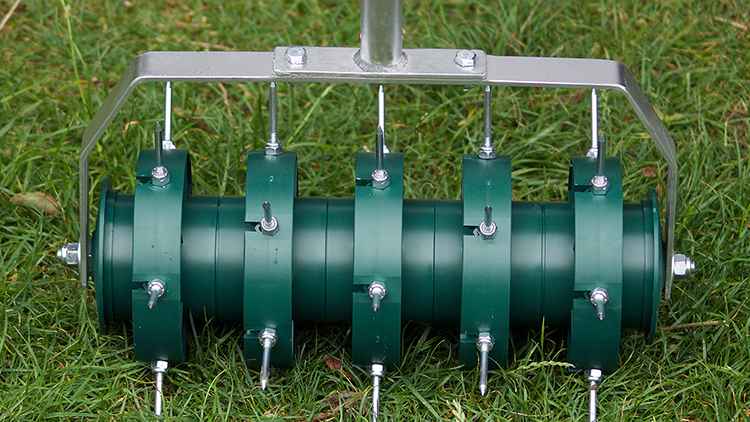Using even the best scarifiers can cause temporary damage to your lawn, so it’s important to know what to do after scarifying your lawn to help it recover as quickly as possible.
Your lawn will recover much faster if you’ve chosen the right time to scarify, as the weather helps by providing sun, warmth, and rain.
But for your lawn to recover as quickly as possible and look the best it ever has; it will need a little help.
What to Do After Lawn Scarifying
Your reason for scarifying will decide what you should do next.
If you scarify as part of your annual lawn maintenance regime, you need to overseed with new grass seed and apply a lawn feed as a minimum.
If instead you’re restoring or repairing your lawn, I suggest you complete all these steps in the order they’re listed.
Aerate Your Lawn, Either by Spiking or Hollow Tining
To do the job properly it’s a good idea to aerate your lawn.
If your lawn is in good condition and you’ve scarified as part of your lawn maintenance schedule, spike it with a garden fork, aerator sandals or a rolling aerator.
This will improve airflow within the turf and the penetration of water and nutrients into the soil and encourage deeper rooting.
If you find that the soil is compacted and hard, use a hollow tine aerator instead. You can buy hollow tining forks from DIY centres, or for larger areas, it can be more efficient to hire a machine instead.
The process of hollow tining removes thousands of cores of turf from the grass sward which creates space for the rest of the soil to fall into. This process provides all of the same benefits of spiking.

Add a Top Dressing (Optional)
For most lawns, top dressing is an optional extra which will take time as well as cost you money.
If you scarified as part of a lawn renovation you should top dress to add nutrients and microbes back into the existing soil.
If you own an ornamental lawn, then top dressing will even it out and make it flatter. The micro-organisms in the top dressing will also control the build-up of thatch.
Overseed
When you’ve scarified or raked, there will be less grass in your lawn.
If you’ve had a moss or thatch problem, it is likely you’ll have some bare patches.
It’s important to overseed to replace lost grass. If you don’t, not only will your lawn look sparse, but the chances of a weed infestation are much higher.
By overseeding, your grass will recover faster. As a benefit, thick grass means there is less room for weeds to grow.
Choose the best grass seed for your lawn and the environment / location you live in.

Apply a Fertiliser
To give the grass a boost of nutrients and support new growth, you should apply a lawn feed.
This will encourage the germination of new grass seed and give the existing grass the chemical nutrients it needs to grow and repair itself.
The best lawn feed to use depends on the time of year (season).
If it’s spring, use a spring / summer feed. If it’s autumn, use an autumn / winter feed.
Water (If Required)
To activate the fertiliser and encourage the germination of new grass seed, the soil needs moisture.
Spring and autumn usually feature plenty of rain to help your lawn recover, but if conditions are dry, you’ll need to turn the sprinklers on or use your garden hose.
Use a hose with a fine sprinkler spray nozzle setting, as watering too heavily can wash the grass seed away before it can take root.
Read our guide on how to scarify your lawn for more information.
Final Verdict
Knowing what to do after scarifying is important for your lawn to recover quickly.
Given between 4 to 6 weeks and your lawn will be looking better than ever.